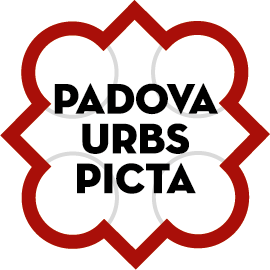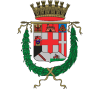This itinerary thematically links together the locations in the city that are most significant from the point of view of religious devotion. A good part of it is within the Restricted Traffic Zone , so it is advisable to use public transport. Even the three places outside the city centre can be reached without a car: the Oratory of St. Michael at Pozzoveggiani and the Sanctuary of St. Anthony (or Sant’Antonino) at Arcella can be reached by bus, and the Sanctuary of St. Leopold Mandic can be reached by either bus or tram.
The Origins of Christianity in the City
Religious devotion has always been an important presence in Padua, even since the city was converted to Christianity by Vitalianus, the Roman Prefect of the city and, probably, the father of St. Giustina. As an aedicula in Prato della Valle commemorates, St. Giustina herself was arrested at Porta Pontecorvo, then suffered martyrdom in the Circus Maximus, which occupied what is now the site of that vast city square. Her presence in the area of Pontecorvo was probably no accident, as we know that the Early Christians used to gather together in the area to the south of the city, outside the walls. In fact, it seems that Vitalianus owned a farm at Pozzoveggiani, the name said to come from the Latin puteus Vitaliani [Vitalianus’s Well], which some think was actually the well [pozzo] that can still be seen on the southern side of the Oratory of St. Michael the Archangel. The place was already one of pagan devotion, given that it was the site of a Temple of Fortune, but very early on it became a focal point of Christian worship. The consacration of the Oratory of St. Michael the Archangel probably occurred at the time of the Longobards, veneration of this saint being very widespread amongst the Christian peoples of Northern Europe. It seems likely, therefore, that St. Giustina was returning to the city from a gathering of the Christian community when she was arrested. (Legend has it that where she knelt to pray, the stone itself softened so as not to hurt her knees.) It would be her refusal to abjure her faith that then led to her martyrdom in the Circus Maximus, located in the area now occupied by Prato della Valle, which was subsequently chosen by Benedictine monks as the site of a large basilica dedicated to the saint. However, just as Milan had its “Duomo worksite”, where construction proceeded apace yet never seemed to finish, Padua would have its “Santa Giustina worksite”: natural disasters – medieval Padua suffered repeated earthquakes, fires and floods – and renewed projects of arhcitectural embellishment meant that the basilica was under construction for centuries. Meanwhile, the Benedictines themselves would prove to be a very importance influence upon the development of the city and its cultural life: both here and at the nearby Abbey of Praglia, they would from the Middle Ages onwards be patiently at work producing manuscripts and incunabula, as well as setting up what has become one of the most important schools in the world for the conservation and restoration of holy icons.
The Development of Religious Orders and the Arrival of St. Anthony.
As well as the Benedictines, other religious orders were present in twelfth-century Padua: the Carmelites, at the Basilica del Carmine; the Augustinians, at the monastery of St. Augustine in Riviera Paleocapa (suppressed and demolished by the French forces under Napoleon); and various other congregations that were less significant in the history of the city. The thirteenth century then saw the arrival of the Franciscans, who founded various monasteries in the area, the most important of which were those in Borgomagno and at Camposampiero. It was because of their presence here that Fernando Martins de Bulhões of Lisbon, who had taken the name Antonio when he entered the Franciscan order, was sent to Padua to oversee the friars in the Veneto area and in Ferrara. He lived in Padua only two years before he fell ill and then died. His monastic cell is still preserved within the church of St. Antony in Arcella; the original church of Sant’Antonio in the city, that place of worship is now known by the diminutive ‘Sant’Antonino’, which it acquired after the construction of the massive Basilica dedicated to the saint. The saint’s short time in the city would have a profound effect: through his preaching; through his miracle-working; and through his intervention in various aspects of public life. He was particularly active in trying to reconcile the ideological divisions between Guelphs and Ghibellines (supporters of the secular power of the Papacy and of the Holy Roman Empire, respectively). The former were represented by the Bishop and many of Padua’s noble families, the latter by the Ezzelini family, lords of Romano, Onara and Bassano. Aiming to expand their power to Treviso, Padua and Vicenza, the Ezzelini hoped to strengthen their position through strenuous support for the Emperor Frederick II; ultimately, they even became members of his family after Ezzelino III, known as ‘The Terrible’, married the emperor’s illegitimate daughter, Selvaggia di Hohenstaufen. St. Anthony’s close links with the city meant that the Franciscan monk was soon known as Antonio da Padova, and within the city itself he would ultimately be simply Il Santo, as if there were no need to identify which saint one was referring to. Upon his death, the city immediately decided to construct a magnificent basilica that would be worthy of the respect, affection and devotion St. Anthony had generated. Given the size and complexity of the structure, the work was completed in record time, its style a combination of Romanesque and Gothic, of the Byzantine and the North European, of West and East. Irrespective of whether they are religious or not, anyone coming to the city should not fail to visit the Basilica, the Piazza in front of it and the Oratory of St. George (map: 4).
Religious Devotion and History
One of the oldest extant churches in the city is that of Santa Sofia; like the Oratory of St. Michael the Archangel, this too was built on the remains of a Roman temple, perhaps dedicated to Juno, perhaps to Mitra. A rare example of Romanesque architecture in Padua, its elegant simplicity and atmospheric crypt (plus other underground spaces) make it well worth a visit. A short distance away stands the church of San Francesco. This has played an extremely important role in the history of the city: being a focus of charity for the poor and needy, it ultimately led to the foundation of a hospital in this area, a facility that would encourage the study of medicine for which the University of Padua was – and is – famous. Another centre of popular devotion, in part because of the altar dedicated to St. Rita, is the church of San Canziano in the street that leads from the Canton del Gallo to Piazza delle Erbe. This church still celebrates the traditional Latin Mass (see the site www.unavoce-ve.it/padova.htm) . Tucked away between Via Dante and the Teatro Verdi, the small church of San Nicolò owes its fame not only to an intimate, meditative, interior, but also to the magnificent small square in which it stands. And a Religious Itinerary would not be complete without a visit to the Duomo, the Baptistery and the Diocesan Museum; the whole interior of the Baptistery is covered with one of the most spectacular – and best-preserved – cycles of fourteenth-century frescoes anywhere in Italy. A more recent construction is the Sanctuary of St. Leopold Mandic,. This is dedicated to a Croatian-born Capuchin monk who passed almost the entirety of his religious life within the monastery next to the church of Santa Croce, where he gave confession and comfort to generations of the faithful.












